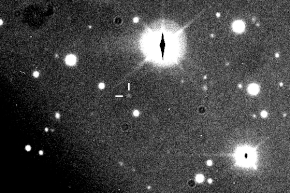 Discovery images of Euporie by the Canada-France-Hawaii Telescope in December 2001 Discovery images of Euporie by the Canada-France-Hawaii Telescope in December 2001 | |
| Discovery | |
|---|---|
| Discovered by | Scott S. Sheppard et al. |
| Discovery site | Mauna Kea Obs. |
| Discovery date | 11 December 2001 |
| Designations | |
| Designation | Jupiter XXXIV |
| Pronunciation | /ˈjuːpəriː/ |
| Named after | Ευπορία Eyporia |
| Alternative names | S/2001 J 10 |
| Adjectives | Euporian /juːˈpɔːriən/ |
| Orbital characteristics | |
| Semi-major axis | 19302000 km |
| Eccentricity | 0.144 |
| Orbital period (sidereal) | −550.7 days |
| Mean anomaly | 293.0° |
| Inclination | 145.8° |
| Longitude of ascending node | 64.9° |
| Argument of perihelion | 74.6° |
| Satellite of | Jupiter |
| Group | Ananke group |
| Physical characteristics | |
| Mean diameter | 2 km |
| Apparent magnitude | 23.1 |
Euporie /ˈjuːpəriː/, also known as Jupiter XXXIV, is a natural satellite of Jupiter. It was discovered by a team of astronomers from the University of Hawaii led by Scott S. Sheppard in 2001, and given the temporary designation S/2001 J 10.
Euporie is about 2 kilometres in diameter, and orbits Jupiter at an average distance of 19.266 million km in 550.69 days, at an inclination of 145.7° to the ecliptic, in a retrograde direction and with an eccentricity of 0.148. It is affected by the Kozai mechanism.
It was named in August 2003 after Euporie, a Greek goddess of abundance and one of the Horae in Greek mythology (and thus a daughter of Zeus). It is a member of the Ananke group.
References
- ^ Brian G. Marsden (15 May 2002). "MPEC 2002-J54: Eleven New Satellites of Jupiter". International Astronomical Union Minor Planet Center.
- per "eupory". Oxford English Dictionary (Online ed.). Oxford University Press. (Subscription or participating institution membership required.)
- per "euporia". Oxford English Dictionary (Online ed.). Oxford University Press. (Subscription or participating institution membership required.)
- S.S. Sheppard (2019), Moons of Jupiter, Carnegie Science, on line
- Daniel W. E. Green (16 May 2002). "IAUC 7900: Satellites of Jupiter". International Astronomical Union.
- "Planetary Satellite Mean Elements". ssd.jpl.nasa.gov. Retrieved 19 January 2024.
- Brozović, Marina; Jacobson, Robert A. (9 March 2017). "The Orbits of Jupiter's Irregular Satellites". The Astronomical Journal. 153 (4): 8. Bibcode:2017AJ....153..147B. doi:10.3847/1538-3881/aa5e4d. ISSN 0004-6256.
- Daniel W. E. Green (9 August 2002). "IAUC 8177: Satellites of Jupiter, Saturn, Uranus". International Astronomical Union. Archived from the original on 27 March 2012.
| Moons of Jupiter | |
|---|---|
| Listed in increasing approximate distance from Jupiter | |
| Inner moons | |
| Galilean moons | |
| Themisto | |
| Himalia group (9) | |
| Carpo group (2) | |
| Valetudo | |
| Ananke group (26) | |
| Carme group (30) | |
| Pasiphae group (18) | |
| See also | |
This article about the planet Jupiter, its moons, their geology or related features is a stub. You can help Misplaced Pages by expanding it. |